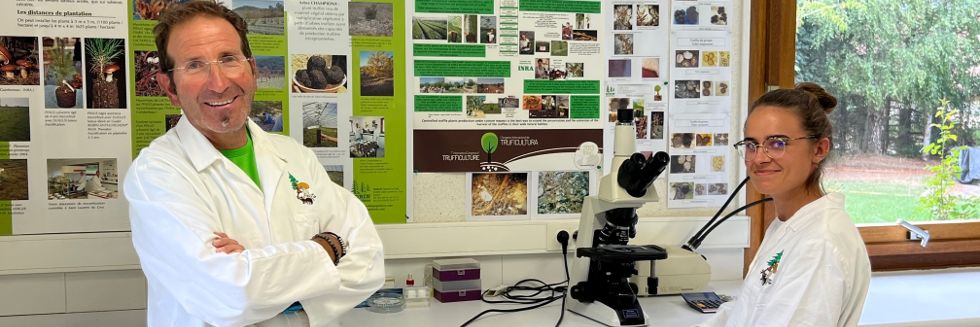
What is controlled mycorrhization ?
What exactly is mycorrhization ?
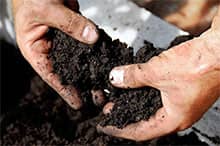 Mycorrhization consists in making the roots of a plant (generally a tree) cohabit with previously selected strains of fungi. The goal of this " wedding " is to generate a symbiosis between the plant and the fungi. The first one will benefit from the nutritive elements induced by the presence of the fungus (nitrogen or phosphorus for example), while the latter will feed on the sugars resulting from the photosynthesis of the tree or the plant..
Mycorrhization consists in making the roots of a plant (generally a tree) cohabit with previously selected strains of fungi. The goal of this " wedding " is to generate a symbiosis between the plant and the fungi. The first one will benefit from the nutritive elements induced by the presence of the fungus (nitrogen or phosphorus for example), while the latter will feed on the sugars resulting from the photosynthesis of the tree or the plant..
As you can see, mycorrhization is a win/win alliance between a plant and fungal strains (mushrooms). From the meeting between this fungus (from the Greek mukês) and a root (rhiza) of the tree is born what we call mycorrhiza. In addition to promoting nutrient exchange, the mycorrhiza offers the plant enhanced protection against possible soil pollution. The fungus is indeed able to filter pollutants, which has the effect of protecting the surrounding roots.
Why use mycorrhization ?
As previously explained, mycorrhization allows to reinforce the nutritive contribution of a plant or a tree without resorting to chemical fertilizers. It also offers a real bulwark against the harmful effects of soil pollution on plants.
This technique of arranged symbiosis leads to an improvement of the performances (of recovery and growth) of the young plants used in plantation. Whether it is in the framework of reforestation or revegetation of particularly poor or difficult soils (industrial wastelands, areas ravaged by fire...), the use of mycorrhizal seedlings allows to obtain much better results than with traditional forestry seedlings.
Although the association induced by mycorrhiza occurs naturally in certain species such as birch and pine, this process is increasingly being recreated "artificially" by professionals. In fact, by promoting mycorrhiza, arborists can significantly reduce the use of chemical fertilizers, which promotes biodiversity while limiting treatment costs.
In concrete terms, how does controlled mycorrhization work ?
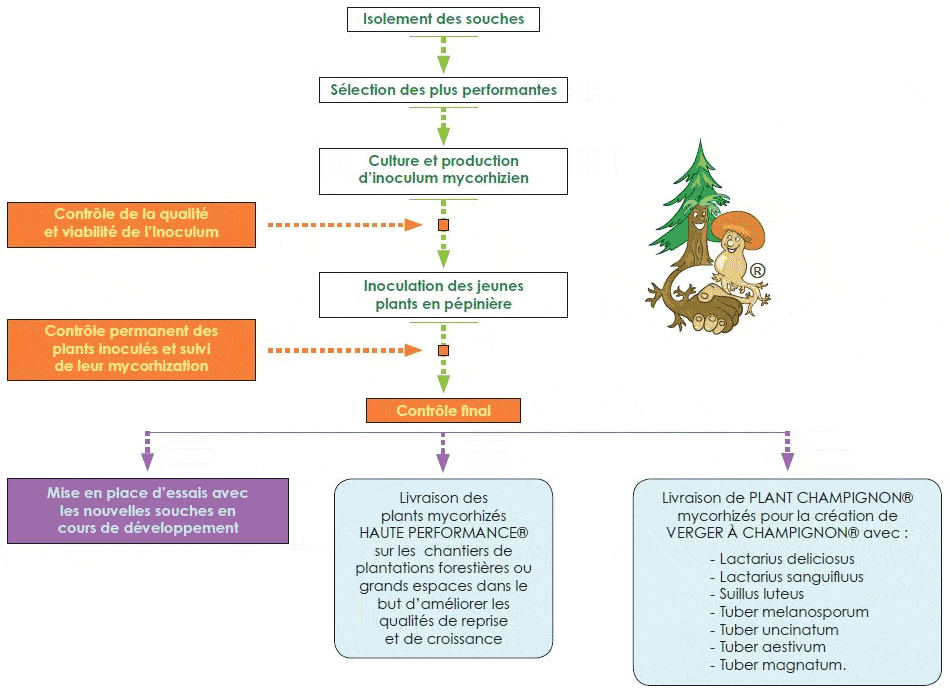 The goal of mycorrhization is to reproduce as well as possible what nature generates itself, namely to initiate and facilitate symbiosis between the roots of a young plant and fungi.
The goal of mycorrhization is to reproduce as well as possible what nature generates itself, namely to initiate and facilitate symbiosis between the roots of a young plant and fungi.
To do this, we will inoculate the mushroom or truffle to a young plant (its juvenility being the guarantee that it is not already in symbiosis with another fungus).
On paper, this operation seems easy, but it requires several preliminary steps that are :
- the isolation of the strains of mushroom or truffle
- the selection of the most efficient strains
(only mature truffles are kept) - their cultivation to produce the inoculum
(the sample that will inoculate the plants later)
At this stage, nothing is won yet and it is advisable to proceed to a first quality control to ensure the viability of the inoculum obtained. If this control confirms the durability of the mycorrhizal inoculum, then the inoculation of the young plants takes place in the nursery. During the months following the inoculation, the plants are regularly monitored and controlled to ensure that the mycorrhization is effective and that it evolves positively. To do this, the mycelium that develops naturally around the spores of the fungus is observed in the laboratory. This mycelium will :
- either graft directly to the cells of the plant's root system (this is called endomycorrhiza),
- or form a kind of sleeve around the root system of the plant (we speak then of ectomycorrhiza).
At the end of this process, we obtain a young mycorrhized plant, ready to be planted.
Endomycorrhiza vs ectomycorrhiza, what are the differences between the two ?
There are different types of mycorrhizae, but our work focuses on endomycorrhizae and ectomycorrhizae, whose characteristics and differences are as follows :
- Ectomycorrhizae concern only 3 to 5% of terrestrial plant species, but they have considerable forestry importance. Ectomycorrhizae are of interest for :
- the production of edible mushrooms (milkcap, boletus, amanite, chanterelle, black truffles of Périgord, Burgundy truffle, white summer truffle or even white truffle of Italy).
- The forest environment by applying on a wide range of coniferous or deciduous hosts: Pine (Pinus), Spruce (Picea), Fir (Abies), Oak (Quercus), Hazel (Corylus), Chestnut (Castanea), Lime (Tilia), Poplar (Populus), Cedar (Cedrus)…
- For their part, endomycorrhizae represent the most widespread form of symbiosis since they colonize more than 90% of terrestrial plants. They concern particularly ornamental or fruit species but they are also associated with forest species such as Ash (Fraxinus), Maple (Acer), Walnut (Juglans) or Prunus.
What are the benefits of controlled mycorrhization ?
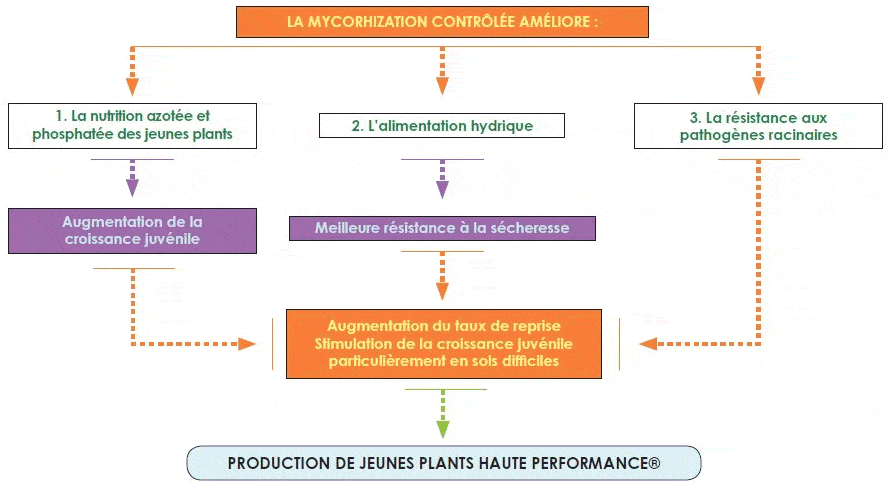 Mycorrhizae (the symbiotic association between plant and fungus) exist naturally in traditional nurseries. Most of the time, they are fungi without interest for the further development of the plants. In forests, mycorrhizae are also abundant and are necessary for the good growth of trees. But they disappear very quickly, only 1 to 2 years after a clear cut.
Mycorrhizae (the symbiotic association between plant and fungus) exist naturally in traditional nurseries. Most of the time, they are fungi without interest for the further development of the plants. In forests, mycorrhizae are also abundant and are necessary for the good growth of trees. But they disappear very quickly, only 1 to 2 years after a clear cut.
On the other hand, mycorrhizae are totally absent on former agricultural lands and in disturbed sites (roads, highways, mines, quarries, industrial wastelands). In these conditions, traditional plants show their limits and can encounter enormous problems of recovery and growth.
This is why Robin Nurseries has developed controlled mycorrhization, under license and control of INRAE, to improve the performance of young plants, and greatly increase their recovery rates in sites in difficult conditions.
The interests and the role of the controlled mycorrhization are multiple, you can discover them simply and in details through the diagram below.
As you may have understood, the main advantages of mycorrhizal plants lie in :
- their higher recovery rate than conventional plants (fewer planting failures are observed),
- their more regular and faster growth,
- their ability to cope with poor or difficult soils,
- their better resistance to drought
To summarize, the use of controlled mycorrhization allows the development of the plants' root network, ensures a better resistance to drought and diseases and consequently generates a better harvest (more roots, flowers and fruits).
Robin Nurseries, leader in controlled mycorrhization
Robin Nurseries is a leader in research and innovation in the field of mycorrhization. Their work on the subject began in the 1960s and in 1998, they were awarded the Life Sciences Prize for their research and development work on controlled mycorrhization.
This work allows us to be currently the only nursery in Europe able to master all the stages of production and control of mycorrhized plants with different fungi on a wide range of host species for different types of uses (truffle orchard, mushroom cultivation, reforestation, vegetation in difficult environments...)
To call upon Robin Nurseries is to benefit at the same time :
- A visit on your land for a soil analysis before planting
- Advice and know-how of our teams
- Home delivery
- A recovery guarantee
The Robin mycorrhization laboratory
Since 1990, ROBIN Nurseries has made the deliberate choice to develop controlled mycorrhization in-house, in their own laboratory. Research and development have continued for many years with the constant desire to innovate and improve the quality of its productions.
The activity of our controlled mycorrhization laboratory includes multiple steps from the isolation of the strains to the final control of the mycorrhized plants before their shipping.
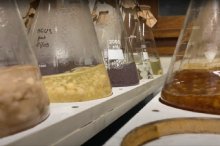
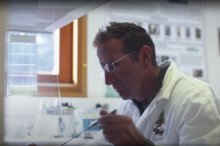
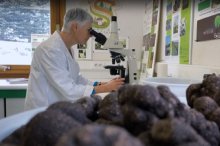
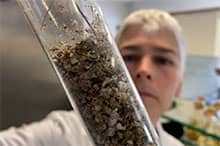
(Click on the pictures to zoom in)
It should be noted that the development of controlled mycorrhization has been carried out within the framework of European programs, with the help of ANVAR and in collaboration with :
- INRAE
- CEMAGREF
- the CNRS of Nancy
- the Université of Diepenbeck (Belgium)
- the Université of Cologne (Germany)
- the Université of Krakow (Poland)
- the Université of Kiev (Ukraine)
- the Université of Budapest (Hungary)
- IPLA (Institute of the Piedmont Region, Italy)


Why buy a truffle plant whose mycorrhization has been controlled ?
There are many reasons to invest in truffle plants from controlled mycorrhization. The most beautiful truffles, especially Tuber melanosporum and Tuber magnatum, are always in demand. And, as a result, their selling price is high. The planting of mycorrhizal truffle plants is therefore a real investment for the future.
However, it is important to plant quality trees, mycorhized and controlled with irreproachable mushrooms and according to a proven and controlled scientific method, implemented in a controlled mycorhization laboratory. This is what ROBIN Nurseries, the world leader in the production of mycorrhized truffle plants, offers you.
Indeed, thanks to the progress of controlled mycorrhization, it is now possible to cultivate truffles. By planting truffle plants mycorhized with this or that variety of mushroom, you will be able to harvest your first truffles within a few years.
Note that after mycorrhization, different tree species are eligible for truffle growing:
- the truffle oak (pubescent oak, pedunculate oak, holm oak, or kermes oak),
- the truffle hazel (common hazelnut, hazelnut of bizance, fruit hazelnut),
- the truffle lime tree or basswood
- the truffle hornbeam (common hornbeam, hop hornbeam)
- the truffle cedar (Atlas cedar)
- the truffle rockrose
- the truffle beech
- the truffle pine (Austrian black pine, Aleppo pine)
What is the price of a mycorrhized truffle plant ?
The price of a truffle oak depends on different criteria :
- its age, its stage of growth: ROBIN truffle plants are 1, 2 or 3 years old
- its presentation : ROBIN truffle plants are produced in our ROBIN ANTI-CHIGNON® cups of different volumes : 0,43 L ; 0,6 L ; 1,5L. The interest of a plant raised in a larger volume cup is mainly to have a more developed root system with a larger number of root apices and therefore a greater number of mycorrhizae, hence the interest of controlled mycorrhization.
- the variety of truffles with which it is mycorhized: Black truffle, white truffle, Burgundy truffle, summer truffle
Our truffle plants are sold individually. You can benefit from a discount depending on the quantity chosen. To maximize your return on investment, ask our truffle experts for advice. They will help you choose the truffle oak plant best suited to your land and soil conditions.